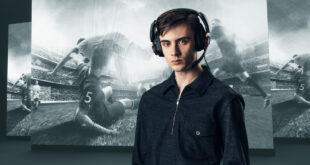Put together Forza Motorsport 4 and racing car audio specialist Nick Wiswell, and arguably you have a marriage made in game audio heaven.
UK game audio’s loss was US studio Turn 10’s gain as Wiswell and his family upped sticks, moving from Cheshire to Redmond just over one year ago.
With a wealth of experience garnered whilst working on global hits like Project Gotham Racing, he nevertheless faced some fresh career challenges.
Previously heading an in-house team of sound designers and audio programmers, he was confronted with a fundamentally different modus operandi – a small core staff team ‘focused on the bigger picture’ scaling up with outsourcers and freelancers based on specific project needs and using audio middleware.
“The manifesto for audio was clear: to make the racing sound more exciting, improving the car audio to be more visceral,” explains Wiswell.
“My predecessors had been looking at the potential for additional dynamic mixing and DSP which fell right into my wheel house; so I took that and ran with it.
"We didn’t want to over-amp things too much and break realism, but we were definitely looking for enhanced excitement.”
TRASH TALKING
Wiswell identified two key areas where a different approach could supply big wins: “I developed already ongoing discussions with iZotope about getting their Trash distortion running on FMOD. They gave it a go and made it work. The result is we have Trash running real-time on our car audio.
“Sure, it’s a little cut down from the pro-audio plug-in but it’s still allowed us to shape the sound significantly and really capture some of that visceral feeling.
"In real life, these cars are seriously loud, and trying to simulate the awesome volume that kicks you in the guts as they pass by – on tiny half-inch LCD TV speakers – is just never going to happen.
"However, using something like Trash, we can get an ‘on the limit’ vibe – the way the sound kind of distorts in your head. It helps give the cars an extra sense of power and speed.”
This TV speaker awareness also informs the mixing methodology, with Wiswell always mindful that some 50-to-60 per cent of players will hear the game on limited playback systems – which is why a pair of Avantone ‘Mix Cubes’ are standard issue for audio staff.
Not that those with high-end hi-fi are forgotten.
“We’ve created bespoke LFE content to create something consistent across all cars – just as for the car engine, we have a bed that’s sitting there tracking the game physics, trying to respond and communicate the feel of the car,” says Wiswell.
“The other area of audio we’ve really focused on is the tyres – such a crucial game-play feedback mechanism.
"Quite often, though you can’t feel it, you can hear the limit. On joining Turn 10, I found out they were getting new tyre physics data direct from Pirelli for use with a new tyre physics model.
“This presented a great opportunity to take the tyre audio up a notch, adding parameters for much more fine grain control.
"This means you can hear a clearer difference between various types of forces being applied – say, skidding due to locked brakes as opposed to drifting sideways or wheel spin. It’s a whole new layer of feedback that’s not been in the game before.”
ELECTRONIC ART
One of the many benefits of being part of the Microsoft Game Studio’s family is a central audio resource storing extensive libraries.
Wiswell discovered a tyre recording session on file that had been conducted using a Tesla electric sports car – no petrol engine but power enough to light up the tyres.
“The bespoke library had absolutely everything we needed and we didn’t have to spend hours trying to extract the engine audio,” he confirms.
“So in the new tyre model, we have hundreds of different sounds and skids for each surface type. In fact, it’s more complex than the engine model overall because we’re tracking lateral and longitudinal forces as well as the amount of load on each tyre – there are different sample sets for loaded/unloaded.
"As you go into a corner and turn, one tyre’s being forced into the ground, while another’s being slightly lifted off the surface and the sonic characteristics in each case are completely different.”
Apparently, hardcore Forza drivers within the studio expressed some hesitancy about changing the tyre sounds until they found they could actually improve their lap times based on the added feedback.
With a smart dynamic mixing system, Kinect support and a collaborative partnership with BBC’s Top Gear – featuring entertaining VO from Jeremy Clarkson – plus more than 500 vehicles’ worth of expertly recorded and implemented car audio that changes as you upgrade and customize your motor, Forza 4’s audio is all set to impress.

 MCV/DEVELOP News, events, research and jobs from the games industry
MCV/DEVELOP News, events, research and jobs from the games industry


